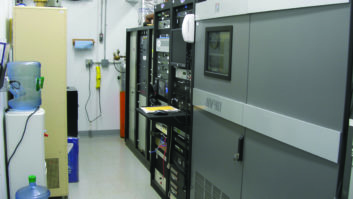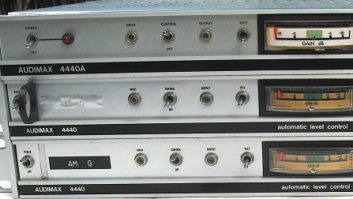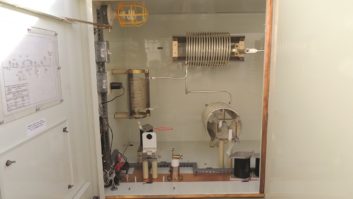
Fig. 1: Cover equipment rack doors with pictures of that station’s transmitter site.

Fig. 2: Visual in the TOC help dispel some of the mystery about off-site transmitter and tower facilities.
Randall Rocks leads the engineering team at Cumulus’ Boise, Idaho, cluster. Along with his associate Bill Frahm, they make it a point to keep their staff informed.
Figs. 1 and 2 are examples. Equipment racks in the Boise technical operations center have solid front doors and are organized by station. So the staff can see what each transmitter site looks like, Randall and Bill have posted pictures of each station’s site. Further, tours of the site are available for employees. This is also helpful for new employees to see what a transmitter site actually looks like.
Non-technical folks hear about a transmitter site or tower but really have no idea what it means. In the age of smartphone technology, snapping transmitter site pictures and posting them gives your staff a better idea of what you do and takes little effort.
One creative engineer I know posts a weekly “What is it?” picture in the staff break room. Photos of burned components, snakes or other animals and other curious things found at the remote site help bring your staff into the world of engineering.
If you maintain an AM and invite the sales staff to visit, bring along a fluorescent tube. As the tube illuminates because of the RF in the room, you can demonstrate how the signal weakens as the tube is moved further away from the RF source. This demonstration will stick with them for years! I still remember the first time I saw it done as a lad of 12.
***

Fig. 3: A blank panel mounted on long standoffs prevents switches or other front-panel components from being bumped by the studio chair.
Bill Frahm shared a solution to a problem common in studios: the chair banging into equipment mounted in the vertical rack space to the left and right of the console.
In his picture, Bill mounted a blank panel on standoffs. Long bolts with nuts will also work. Seen in Fig. 3, the panel absorbs any shock from the studio chair, but allows fingers to slip in and access the switches, if needed.
***

Fig. 4: Daniel Hyatt found another use for the vinyl used to wrap station vehicles: Apply it to your studio furniture.
Remodeling studios can include furniture changes, too. But if you don’t have the budget for wholesale studio furniture replacement, you might want to consider what Daniel Hyatt of Denver’s Max Media did.
Taking a cue from the vinyl wrap we often see used on station vehicles, Daniel had his console furniture wrapped. Fig. 4 shows the results.

Fig. 5: A sleek but inexpensive studio tabletop.
Speaking of furniture solutions, Eric Ostlund is assistant engineer for One Putt Broadcasting in Fresno, Calif. Eric recently completed a new facility build; when it came to studio furniture, Eric found that simple was better.
Since there’s not as much equipment in today’s AoIP studio, the simple curved tabletop, shown in Fig. 5, looks sleek and is supported by a brushed aluminum post.
***
Rychard Withers is general manager for KFCF(FM), also in Fresno, Calif. “Free Speech Radio for Central California” depends on both listener contributions and community volunteers to generate 20 percent local programming. The station is involved heavily with the community, giving many on-air guests their first broadcast experience.

Fig. 6: Eliminate the problem of guests sounding “off mike” by switching to a headphone/boom mike combination.

Fig. 7: A small dot of nail polish helps orient the boom mic.
To improve microphone technique, Rychard ditched the typical mic stands and headphones and invested in the Audio-Technica combination headphone/boom mic, seen in Fig. 6.
Once on the guest’s head, and after adjustment, it doesn’t matter if the guest turns to speak to a host or another guest during a roundtable discussion — the adjustable boom ensures they are always “on mic.”
Rychard also painted a small dot on the end of the boom mic, shown in Fig. 7, so operators can be sure the guest is speaking right into the element.
For more information, head to www.audio-technica.com.
Workbench — Radio World’s iconic and most popular column — relies on your good, practical ideas and those of your colleagues. Send in tips big or small; help your fellow engineers and qualify for SBE recertification credit. Email [email protected]. You can even (gasp) fax them to (603) 472-4944. And discover a trove of past tips by clicking on the Columns & Views tab at radioworld.com, then choosing Workbench.
John is SBE-certified and is a past recipient of the SBE’s Educator of the Year Award.












